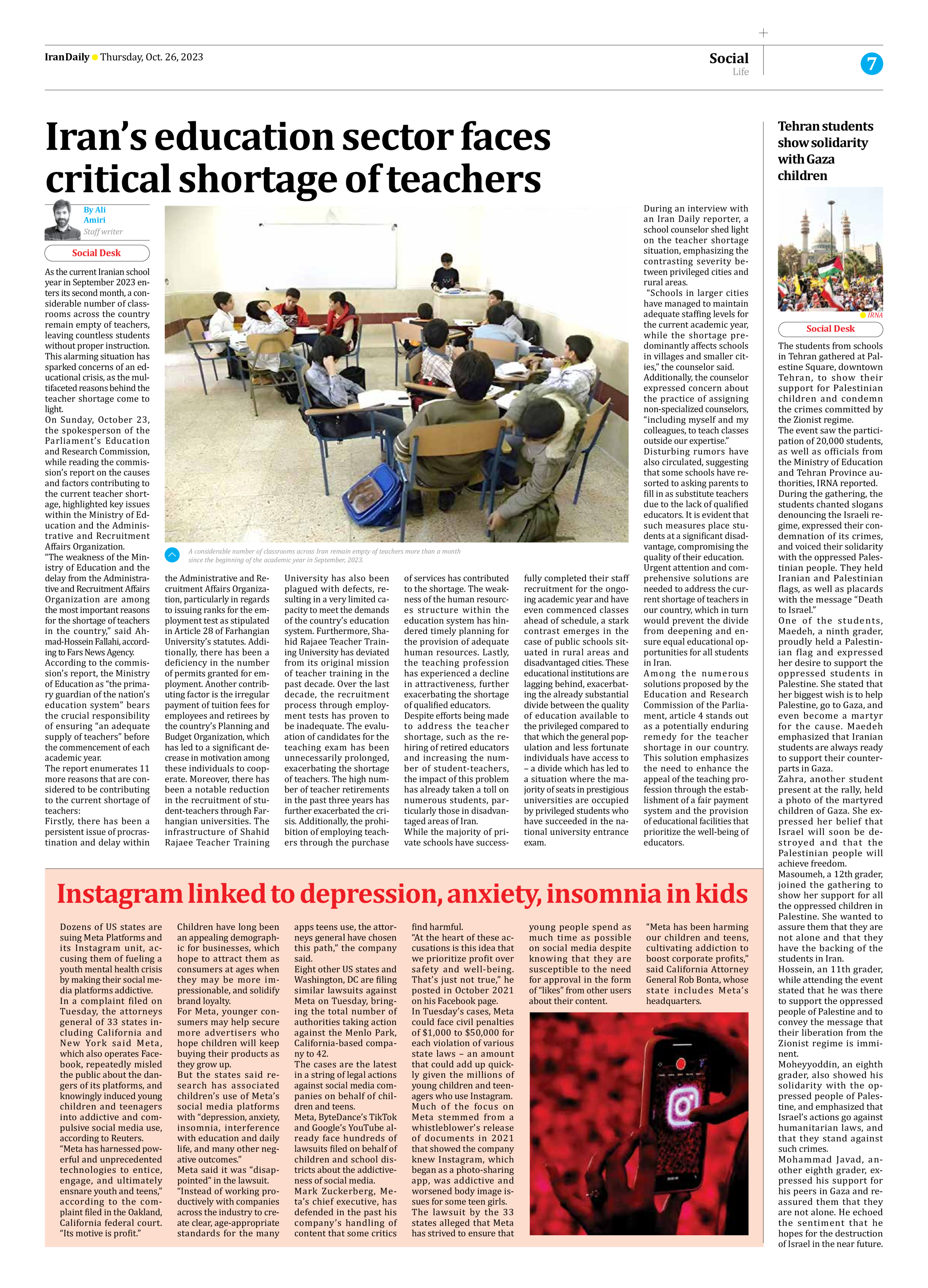
Iran’s education sector faces critical shortage of teachers
By Ali Amiri
Staff writer
As the current Iranian school year in September 2023 enters its second month, a considerable number of classrooms across the country remain empty of teachers, leaving countless students without proper instruction. This alarming situation has sparked concerns of an educational crisis, as the multifaceted reasons behind the teacher shortage come to light.
On Sunday, October 23, the spokesperson of the Parliament’s Education and Research Commission, while reading the commission’s report on the causes and factors contributing to the current teacher shortage, highlighted key issues within the Ministry of Education and the Administrative and Recruitment Affairs Organization.
“The weakness of the Ministry of Education and the delay from the Administrative and Recruitment Affairs Organization are among the most important reasons for the shortage of teachers in the country,” said Ahmad-Hossein Fallahi, according to Fars News Agency.
According to the commission’s report, the Ministry of Education as “the primary guardian of the nation’s education system” bears the crucial responsibility of ensuring “an adequate supply of teachers” before the commencement of each academic year.
The report enumerates 11 more reasons that are considered to be contributing to the current shortage of teachers:
Firstly, there has been a persistent issue of procrastination and delay within the Administrative and Recruitment Affairs Organization, particularly in regards to issuing ranks for the employment test as stipulated in Article 28 of Farhangian University’s statutes. Additionally, there has been a deficiency in the number of permits granted for employment. Another contributing factor is the irregular payment of tuition fees for employees and retirees by the country’s Planning and Budget Organization, which has led to a significant decrease in motivation among these individuals to cooperate. Moreover, there has been a notable reduction in the recruitment of student-teachers through Farhangian universities. The infrastructure of Shahid Rajaee Teacher Training University has also been plagued with defects, resulting in a very limited capacity to meet the demands of the country’s education system. Furthermore, Shahid Rajaee Teacher Training University has deviated from its original mission of teacher training in the past decade. Over the last decade, the recruitment process through employment tests has proven to be inadequate. The evaluation of candidates for the teaching exam has been unnecessarily prolonged, exacerbating the shortage of teachers. The high number of teacher retirements in the past three years has further exacerbated the crisis. Additionally, the prohibition of employing teachers through the purchase of services has contributed to the shortage. The weakness of the human resources structure within the education system has hindered timely planning for the provision of adequate human resources. Lastly, the teaching profession has experienced a decline in attractiveness, further exacerbating the shortage of qualified educators.
Despite efforts being made to address the teacher shortage, such as the rehiring of retired educators and increasing the number of student-teachers, the impact of this problem has already taken a toll on numerous students, particularly those in disadvantaged areas of Iran.
While the majority of private schools have successfully completed their staff recruitment for the ongoing academic year and have even commenced classes ahead of schedule, a stark contrast emerges in the case of public schools situated in rural areas and disadvantaged cities. These educational institutions are lagging behind, exacerbating the already substantial divide between the quality of education available to the privileged compared to that which the general population and less fortunate individuals have access to – a divide which has led to a situation where the majority of seats in prestigious universities are occupied by privileged students who have succeeded in the national university entrance exam.
During an interview with an Iran Daily reporter, a school counselor shed light on the teacher shortage situation, emphasizing the contrasting severity between privileged cities and rural areas.
“Schools in larger cities have managed to maintain adequate staffing levels for the current academic year, while the shortage predominantly affects schools in villages and smaller cities,” the counselor said.
Additionally, the counselor expressed concern about the practice of assigning non-specialized counselors, “including myself and my colleagues, to teach classes outside our expertise.”
Disturbing rumors have also circulated, suggesting that some schools have resorted to asking parents to fill in as substitute teachers due to the lack of qualified educators. It is evident that such measures place students at a significant disadvantage, compromising the quality of their education.
Urgent attention and comprehensive solutions are needed to address the current shortage of teachers in our country, which in turn would prevent the divide from deepening and ensure equal educational opportunities for all students in Iran.
Among the numerous solutions proposed by the Education and Research Commission of the Parliament, article 4 stands out as a potentially enduring remedy for the teacher shortage in our country. This solution emphasizes the need to enhance the appeal of the teaching profession through the establishment of a fair payment system and the provision of educational facilities that prioritize the well-being of educators.







